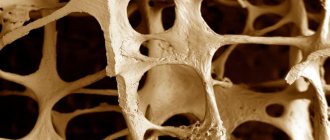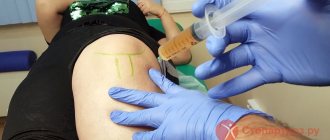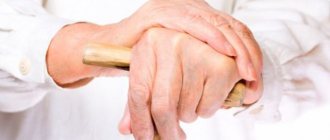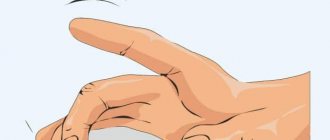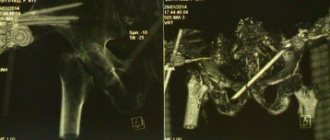Gout is a rheumatic disease caused by the deposition of uric acid salts in the joints. During an acute attack, severe sharp pain in the area of the swollen joint is disturbing. The exacerbation lasts several days, then subsides, but periodically returns. To avoid dangerous irreversible complications, regular monitoring of uric acid levels and its removal from the body is necessary. You can get advice and start treatment for gout in Anapa at the medical office.
Features and causes of the disease
The main cause of gout is hyperuricemia , a persistently elevated level of uric acid in the blood. It can increase both due to its excessive formation, and due to problems with utilization and excretion by the kidneys.
Uric acid is formed from the breakdown of purines and nucleic acids. It contains urates - insoluble salts that tend to crystallize and accumulate in the joints, destroying them. In the periarthrial form of gout, deposition occurs in the tendons. The process develops slowly, and it may take 10-20 years for the first symptoms to appear.
Other diseases can provoke salt deposition: kidney disease, diabetes, hypothyroidism, arterial hypertension, obesity. Nutrition plays an important role. Meat, seafood, alcohol, and beer are rich in purines. Sugary carbonated drinks make it difficult to remove uric acid. Some medications, including diuretics, can trigger gout.
As a rule, during an attack, one joint becomes inflamed; the big toe, wrist, elbow, and hand are more likely to be bothered. Less commonly, the process affects the knees, arches of the feet, and ankles. An unbearable pressing pain occurs, the site of inflammation swells, becomes hot, and the skin turns red.
After the acute period, the condition returns to normal, but salts continue to accumulate. The next exacerbation may occur in a few months or later. In uncomplicated cases, in the intervals the physiological mobility of the joints is preserved, there is no malaise.
In “experienced” patients, salt deposits are visible to the naked eye - tophi - growths that bother and interfere with everyday activities. Tophi disfigure fingers, toes, feet, and elbows. This course of the disease is called tophi gout.
Gout. Symptoms, treatment
What is gout?
Gout is a form of arthritis that often causes sudden, severe attacks of pain, tenderness, redness, swelling (inflammation) in some joints that may be hot to the touch. A rheumatologist diagnoses and treats gout. Gout most often affects the joint of the big toe, but gout can also affect other joints of the legs (knees, ankles). Less commonly, gout develops in the joints of the hands (wrist and elbow), and almost never in the joints of the spine.
Symptoms of gout.
- Sudden intense pain in the joint, which often first appears in the morning;
- Swelling of the joint, hyperemia of the skin in the joint area.
What causes gout?
Previously, gout was considered a disease of the rich and famous who could afford too much fatty food and wine. It is now known that fatty foods and excessive alcohol consumption can contribute to the development of gout, but they are not the determining causes of the disease. It is now known that gout develops as a result of pathological deposition of crystals (sodium urates) around the articular cartilage, and in later stages in the joint fluid. This process leads to inflammation, accompanied by pain. Urate crystals can also deposit in the kidneys, resulting in the formation of “urate” kidney stones. Scientists believe that this occurs due to excess production of uric acid in the body, or as a result of a decrease in the body's ability to remove uric acid from the blood through the kidneys. Normally, uric acid dissolved in the blood easily passes through the kidneys and is excreted from the body in urine. The cause of so-called primary gout is probably the presence of an abnormal X chromosome that is inherited.
Consumption of certain foods containing large amounts of uric acid also contributes in some cases to the development of gout. These foods especially include red meat and organ meats (such as liver and kidneys), as well as shellfish and anchovies. The level of uric acid in the blood may vary depending on:
- How efficiently your kidneys remove uric acid;
- What you eat;
- Your general health;
- How much alcohol do you drink;
- What medications do you take;
- What concomitant diseases do you suffer from?
Science is not yet clear why gout does not develop in every person with high uric acid levels. It is only known that the ability of the kidneys to remove uric acid from the body is partly determined by heredity. However, this does not mean that if someone in the family suffers from gout, then all family members will suffer from gout. Heredity, along with the risk factors mentioned above (which affect uric acid levels in the blood), as well as male gender and age, increase the risk of developing gout.
How often do gout flare-ups occur?
Attacks of gout may recur from time to time in the same or different joints. The first “attack” can last from several days to two weeks if treatment is not started. Over time, gout attacks may occur more frequently, other joints may be involved, the symptoms of the disease may become more intense, and the attacks may last longer. Repeated attacks can damage the joint. In some patients, gout manifests itself only once, but this is rather the exception. Statistically, about 90 percent of patients who experience one attack of gout will at least experience a second attack, although this may occur for several years after the first attack. Some patients may experience gout flare-ups every two, three, or more weeks.
Who suffers from gout?
The following groups of people are more likely to suffer from gout:
- Men (usually over 40 years of age) and menopausal women;
- People who are overweight;
- People who abuse alcohol;
- People who frequently use diuretics to lower blood pressure or treat chronic heart failure.
Gout can also occur in younger patients if they take certain medications for a long period of time, drink alcohol to excess, or have certain genetic disorders.
How is gout diagnosed?
Gout cannot be diagnosed by blood tests (uric acid levels) alone, as many people have elevated blood uric acid levels but will never develop gout. In addition to a medical examination and studying the medical history, one of the methods for diagnosing gout is puncture of the inflamed joint with the collection of intra-articular fluid for examination. The resulting liquid is examined under a microscope to detect sodium urate crystals. In addition to diagnosis, puncture to remove fluid from the inflamed joint, in some cases, also has a therapeutic, albeit palliative, effect. This occurs due to a decrease in fluid pressure in the joint capsule, which leads to a decrease in pain intensity. The above diagnostic method is simple, but, unfortunately, not always objective. The fact is that with gout, crystals may be absent from the intra-articular fluid. Sometimes crystals are not detected the first time, but can be identified during diagnostic punctures of the joint during subsequent exacerbations. Because gout can cause chronic joint pain and involve other joints, it is extremely important to get an accurate diagnosis and specific treatment as early as possible.
How to treat gout?
Gout belongs to the group of chronic diseases, it is impossible to get rid of it, but at the same time, you can select treatment aimed at preventing relapses (exacerbations). With proper treatment, gout symptoms can often resolve within 24 hours of starting therapy.
The goals of treatment for gout are:
- reduction in intensity or elimination of pain and inflammation;
- preventing future gout flare-ups that can cause joint damage.
The treatment your doctor prescribes will depend on several factors, including the patient's age, medications taken (for other conditions), general health, medical history, and the severity of the gout attacks. The following groups of drugs are used in the treatment of gout:
1. Anti-inflammatory drugs. Anti-inflammatory drugs reduce pain and swelling of the joint during an exacerbation. As a rule, they are prescribed until the symptoms of gout completely stop. Considering that anti-inflammatory drugs have side effects, your doctor will discuss them with you and, if they occur, you may be prescribed another drug. Anti-inflammatory drugs used for gout include:
- Nonsteroidal anti-inflammatory drugs (NSAIDs) are typically prescribed to treat sudden and severe attacks of gout. NSAIDs usually reduce inflammation and pain within a few hours;
- Corticosteroids may be prescribed to patients who cannot take NSAIDs. Corticosteroids, like NSAIDs, reduce inflammation and reduce pain. Corticosteroids may be prescribed as tablets or given as an injection into the affected joint;
- Colchicine. Sometimes used in small doses over a long period of time to reduce the risk of gout relapses. The drug has anti-inflammatory and anti-gout effects.
2. Medicines that affect the level of uric acid in the blood. Some patients may need to be prescribed drugs from this group. Unlike anti-inflammatory drugs, they do not reduce inflammation and pain, but they do help reduce uric acid levels in the blood. Such drugs, for example, include: allopurinol; probenecid and Febuxostat, which is also called Uloric. These drugs are recommended for patients with high uric acid levels, repeated relapses of gout, as well as patients with urate kidney stones. The goal of treatment is to reduce blood uric acid levels to less than 6 mg/dL. As mentioned above, drugs in this group do not relieve symptoms during an exacerbation, but reducing the level of uric acid over time prevents the development of relapses. A sudden drop in uric acid levels can cause an acute attack of gout. To relieve acute attacks of gout in patients taking allopurinol or similar drugs, colchicine or NSAIDs are additionally prescribed until symptoms disappear.
Side effects of medications.
Not everyone experiences side effects from medications, and their occurrence varies from patient to patient. The occurrence of side effects depends on the dose, type of drug, concomitant diseases, or combination with other drugs that the patient is taking. If a rash or itching develops while taking allopurinol, you should stop taking the drug and notify your doctor.
Can gout be treated by following a certain diet?
Excluding certain foods from the diet, for most patients, does not play a decisive role in maintaining the required level of uric acid. However, limiting the above foods that cause increased uric acid synthesis and reducing alcohol consumption are often helpful.
Complications without proper treatment
Lack of treatment in the early stages almost always leads to complications. They can appear after years and even with an asymptomatic form of the disease.
Gouty insoluble nodes (tophi) are deposited in other joints or periarticular tissues, and the inflammatory process begins. Chronic gouty arthritis develops, in which articular cartilage and ligaments are damaged, joints are destroyed, and bones are deformed. The person loses the ability to move normally, the pain becomes constant.
Urate salts can be deposited in the kidneys, leading to urolithiasis , nephropathy and gouty nephritis. Over time, kidney failure is possible. The kidneys cannot cope with their work, which becomes the cause of persistent arterial hypertension.
Expert Research
Specialists at the Mayo Clinic in the USA conducted a study that made it possible to identify the first signs of the disease. This research center is one of the largest private medical and research centers in the world. According to them, gout is characterized by the development of swelling, redness of the skin and pain in the joints - often the joints at the base of the big toe. Symptoms may come and go. But it is possible to control them. You need to visit a doctor who will draw up a treatment regimen and tell you exactly how to relieve the discomfort.
Diagnosis of gout and complications
If you suspect gout, you should consult a rheumatologist. During an exacerbation, the disease is easy to identify. First of all, the doctor examines the inflamed joint, assesses the condition of the skin, the degree of swelling, and other signs.
To diagnose gout, the following is prescribed:
- General blood analysis. During an attack, an increased ESR is noted.
- Biochemical blood test.
- Determination of serum uric acid level.
- X-ray of the joint. Changes appear after a few years and indicate advanced disease and complications - gouty polyarthritis and osteoporosis.
- Puncture to identify sodium urate and microflora in the synovial fluid.
- Ultrasound of the kidneys to detect stones.
Gout is hereditary, so it is important for all family members to be examined regularly, even if there are no signs yet. The development of gout can be avoided if measures are taken in advance.
Therapy methods
Treatment for gout is aimed at controlling the level of uric acid in the body and stopping acute attacks. Drug therapy is prescribed during periods of exacerbation to relieve inflammation and reduce pain. There are drugs that reduce the concentration of uric acid and stimulate its excretion.
To reduce production, a low-salt diet is also prescribed, eliminating foods and drinks rich in purines.
Surgical treatment is carried out to remove gouty tophi if they become inflamed, compress soft tissues and nerve endings, and interfere with blood circulation.
To prevent complications and joint destruction, when only an implant can save you from disability, regularly visit a rheumatologist and do not refuse treatment, even if exacerbations occur infrequently. The diagnostic department will prescribe effective treatment that will help improve the quality of life and avoid consequences.
